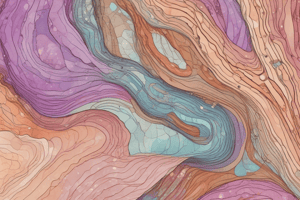Podcast
Questions and Answers
What is the primary cell type in the epidermis responsible for producing keratin?
What is the primary cell type in the epidermis responsible for producing keratin?
- Langerhans cells
- Keratinocytes (correct)
- Merkel cells
- Melanocytes
Which layer of the epidermis is responsible for the beginning of keratinization?
Which layer of the epidermis is responsible for the beginning of keratinization?
- Stratum Corneum
- Stratum Spinosum
- Stratum Lucidum
- Stratum Granulosum (correct)
What type of connective tissue primarily makes up the dermis?
What type of connective tissue primarily makes up the dermis?
- Loose connective tissue
- Dense irregular connective tissue (correct)
- Cartilaginous tissue
- Adipose tissue
Which accessory structure of the skin is involved in thermoregulation?
Which accessory structure of the skin is involved in thermoregulation?
Which cells in the epidermis are primarily responsible for UV protection?
Which cells in the epidermis are primarily responsible for UV protection?
The stratum lucidum is found only in which type of skin?
The stratum lucidum is found only in which type of skin?
Which layer of the skin serves as a connection to underlying structures?
Which layer of the skin serves as a connection to underlying structures?
What type of cells help maintain skin structure by producing collagen and elastin fibers?
What type of cells help maintain skin structure by producing collagen and elastin fibers?
Flashcards are hidden until you start studying
Study Notes
Histology of the Skin
1. Overview of Skin Layers
- Epidermis: Outermost layer, primarily composed of keratinized stratified squamous epithelium.
- Dermis: Middle layer, made of dense irregular connective tissue; contains blood vessels, hair follicles, and glands.
- Hypodermis (Subcutaneous layer): Bottom layer, composed of loose connective tissue and adipose tissue; anchors skin to underlying structures.
2. Epidermis
-
Cell Types:
- Keratinocytes: Main cell type; produce keratin, forming a protective barrier.
- Melanocytes: Produce melanin; responsible for skin color and UV protection.
- Langerhans cells: Immune cells; play a role in skin defense.
- Merkel cells: Sensory cells; contribute to touch sensation.
-
Layers of the Epidermis (from deep to superficial):
- Stratum Basale: Single layer of columnar/cuboidal keratinocytes; mitotically active.
- Stratum Spinosum: Several layers of keratinocytes; provides strength and flexibility.
- Stratum Granulosum: 3-5 layers of flattened cells; keratinization begins here.
- Stratum Lucidum: Only present in thick skin (palms, soles); clear layer for additional protection.
- Stratum Corneum: Outermost layer; composed of dead, flattened keratinized cells; provides barrier against environmental damage.
3. Dermis
-
Components:
- Papillary Layer: Upper layer, contains loose connective tissue; houses blood vessels and sensory receptors (Meissner's corpuscles).
- Reticular Layer: Deeper layer, made of dense irregular connective tissue; contains larger blood vessels, hair follicles, sweat glands, and sebaceous glands.
-
Cell Types:
- Fibroblasts: Produce collagen and elastin fibers; maintain skin structure.
- Mast Cells: Play a role in inflammation and allergic responses.
- Macrophages: Immune cells that help protect against pathogens.
4. Accessory Structures
- Hair Follicles: Structures that produce hair; contain arrector pili muscles that cause hair to stand on end (goosebumps).
- Sebaceous Glands: Produce sebum (oil) to lubricate and waterproof the skin.
- Sweat Glands:
- Eccrine glands: Merocrine glands; involved in thermoregulation through sweat.
- Apocrine glands: Located mainly in axillary and genital areas; associated with hair follicles and release thicker sweat.
5. Blood Supply and Innervation
- Blood Vessels: Arteries and veins supply nutrients and oxygen; regulate temperature through vasodilation and vasoconstriction.
- Nerve Endings: Various receptors (thermoreceptors, mechanoreceptors, nociceptors) that detect touch, pressure, temperature, and pain.
6. Function of the Skin
- Barrier Protection: Prevents pathogen entry and water loss.
- Thermoregulation: Maintains body temperature through sweat and blood flow adjustments.
- Sensation: Detects environmental stimuli via nerve endings.
- Metabolic Functions: Synthesizes vitamin D and stores lipids.
Overview of Skin Layers
- Epidermis: Outermost layer composed of keratinized stratified squamous epithelium, providing a protective barrier.
- Dermis: Middle layer made of dense irregular connective tissue; houses blood vessels, hair follicles, and various glands.
- Hypodermis (Subcutaneous layer): Deepest layer consisting of loose connective and adipose tissue; anchors skin to underlying structures.
Epidermis
- Cell Types:
- Keratinocytes: Primary cell type producing keratin, crucial for skin barrier.
- Melanocytes: Responsible for melanin production, affecting skin color and UV protection.
- Langerhans cells: Act as immune cells involved in skin defense.
- Merkel cells: Sensory cells associated with touch perception.
- Layers of the Epidermis:
- Stratum Basale: Deepest single layer of mitotically active keratinocytes.
- Stratum Spinosum: Several layers providing strength and flexibility.
- Stratum Granulosum: 3-5 layers where keratinization begins.
- Stratum Lucidum: Present only in thick skin for added protection.
- Stratum Corneum: Outermost layer of dead, flattened keratinized cells, crucial for environmental defense.
Dermis
- Components:
- Papillary Layer: Upper layer with loose connective tissue; contains blood vessels and sensory receptors (Meissner's corpuscles).
- Reticular Layer: Deeper, dense layer containing larger blood vessels, hair follicles, sweat glands, and sebaceous glands.
- Cell Types:
- Fibroblasts: Produce collagen and elastin fibers to maintain skin structure.
- Mast Cells: Involved in inflammation and allergic responses.
- Macrophages: Immune cells that defend against pathogens.
Accessory Structures
- Hair Follicles: Structures producing hair; contain arrector pili muscles, responsible for goosebumps.
- Sebaceous Glands: Produce sebum to lubricate and waterproof the skin.
- Sweat Glands:
- Eccrine glands: Merocrine glands involved in thermoregulation through sweat.
- Apocrine glands: Located in the axillary and genital areas; associated with hair follicles and secrete thicker sweat.
Blood Supply and Innervation
- Blood Vessels: Arteries and veins supply nutrients and oxygen; help in regulating body temperature through vasodilation and vasoconstriction.
- Nerve Endings: Various receptors (thermoreceptors, mechanoreceptors, nociceptors) detect touch, pressure, temperature, and pain.
Function of the Skin
- Barrier Protection: Shields against pathogen entry and minimizes water loss.
- Thermoregulation: Controls body temperature via sweating and blood flow adjustments.
- Sensation: Detects environmental stimuli through various nerve endings.
- Metabolic Functions: Involved in synthesizing vitamin D and lipid storage.
Studying That Suits You
Use AI to generate personalized quizzes and flashcards to suit your learning preferences.




